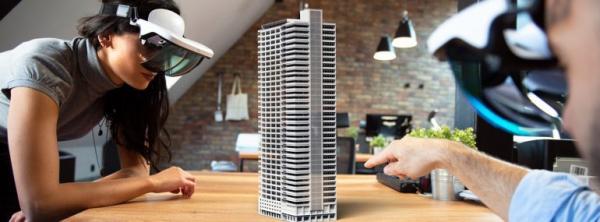
Written by Matthew Ball for www.matthewball.vc
Modern efforts to build extended reality (XR) devices—i.e., dedicated virtual reality (VR), dedicated augmented reality (AR), hybrid mixed reality (MR)—began more than a decade ago. Magic Leap was founded in 2010, the same year Microsoft started development on its HoloLens platform, which released its first model in 2016, with the second coming in 2019. The first Google Glass prototype was in 2011, with the first Explorer Edition coming in 2013 and the Enterprise Edition 2 launching as recently as 2019; a reconceived model was field-tested in 2022. Google’s Cardboard VR platform and software development kit (SDK) came in 2014, with the Daydream VR platform coming two years later. Sony PlayStation began development of its VR platform in 2011, which then debuted in 2016. Oculus was founded in 2012, with Facebook acquiring the company in 2014, and the Oculus Rift coming to market in 2016, followed by another four models through 2022. In 2014, Snap acquired Vergence Labs, an AR glasses start-up that had been founded in 2011, and served as the foundation for the Snap Spectacles, which premiered in 2016, and have seen three updates. Despite the failure of the Fire Phone, a 3D-enabled smartphone that had four front-facing cameras at a time where the smartphones had one or at most two, Amazon began development of its Alexa-based AR glasses sometime in 2016 or 2017. The first Echo Frames was released in 2019, with the second edition coming two years later.
As we observe the state of XR in 2023, it’s fair to say the technology has proved harder than many of the best-informed and most financially endowed companies expected. When it unveiled Google Glass, Google suggested that annual sales could reach the tens of millions by 2015, with the goal of appealing to the nearly 80% of people who wear glasses daily. Though Google continues to build AR devices, Glass was an infamous flop, with sales in the tens of thousands (the company’s 2022 AR device no longer uses the Glass brand). Throughout 2015 and 2016, Mark Zuckerberg repeated his belief that within a decade, “normal-looking” AR glasses might be a part of daily life, replacing the need to bring out a smartphone to take a call, share a photo, or browse the web, while a bigscreen TV would be transformed into a $1 AR app. Now it looks like Facebook won’t launch a dedicated AR headset by 2025—let alone an edition that hundreds of millions might want.
In 2016, Epic Games founder/CEO Tim Sweeney predicted not only that within five to seven years, we would have not just PC-grade VR devices but also that these devices would have shrunk down into Oakley-style sunglasses. Seven years later, this still seems at best seven years away. Recent reporting says Apple’s AR glasses, which were once targeted for a 2023 debut and then pushed to 2025, have been delayed indefinitely. Snap’s Spectacles launched to long lines and much fanfare, with another three editions launched by 2021. In 2022, the division was largely shuttered, with the company refocusing on smartphone-based AR. Amazon has yet to launch any Echo Frames with a screen, rather than just onboard Alexa. Google’s head of VR/AR is a direct report to CEO Sundar Pichai, though the company’s next (i.e., fourth) swing at XR is expected no sooner than 2024. In 2019, Magic Leap raised $300 million at a $7 billion post-money valuation. Two years later, the company raised $500MM at a $2.5B post-money valuation, a 66% drop that also meant the company was worth 30% less than the $3.5B in cash it had raised life-to-date. In January 2022, reports emerged that Saudi Arabia’s sovereign wealth fund had taken majority control of the company following a $450MM equity-and-debt deal, suggesting that the company’s valuation had fallen to less than a billion dollars, possibly down to even half a billion.
Over the past 13 or so years, there has been material technical progress. And we do see growing deployment. Today, XR is selectively used in civil engineering and industrial design, in film production, on assembly lines and factory floors. Some schools use VR some of the time in some classes - and the utility a virtual classroom with virtual Bunsen Burners and virtual frogs to dissect, all overseen by an embodied instructor, while you sit beside and make eye contact with your peers, is obvious. VR is also increasingly popular for workplace safety training, especially in high-risk environments such as oil rigs; teaching personnel how, when, and where people look is already having life-saving applications. And on the topic of saving lives, Johns Hopkins has been using XR devices for live patient surgery for more than a year, beginning with the removal of cancerous spinal tumors. If you use a high-end VR headset such as the Varjo Aero (which also requires a physical tether to a gaming-grade PC and costs $2,000) to play a title such as Microsoft Flight Simulator (which operates a 500,000,000 square kilometer reproduction of the earth, with two trillion individual rendered trees, 1.5 billion buildings, and nearly every road, mountain, and city globally), there is the unmistakable feeling the future is near.
The examples listed above are technically impressive, meaningful, and better than ever . But the future was supposed to have arrived by now. In 2023, it’s difficult to say that a critical mass of consumers or businesses believe there’s a “killer” AR/VR/MR experience in market today; just familiar promises of the killer use cases that might be a few years away. These devices are even farther from substituting for the devices we currently use (and it doesn’t seem like they’re on precipice of mainstream adoption, either). There are some games with strong sales—a few titles have done over $100MM—but none where one might argue that, if only graphics were to improve by X%, large swaths of the population would use VR devices or those titles on a regular basis. I strongly prefer doing VR-based presentations to those on Zoom—where I spend 30-60 minutes staring at a camera as though no one else is there. But the experience remains fraught; functionality is limited; and onboarding other individuals is rarely worth the benefit because its participants seem to find these benefits both few and small. When the iPhone launched, Steve Jobs touted it did three distinct things—MP3 player, phone, internet communicator—better at launch than the single-use devices then on the market. The following year, the iPhone launched its App Store and “There’s an App for That” proliferated, with tens of millions doing everything they could on the device. The “killer app” was that it already had dozens of them when it was touted as the “next thing'“.
The Meta Quest 2 has sold well, with an estimated 20MM+ units since November 2020. This is broadly comparable to the sales of the Xbox Series X and PlayStation 5, which were released at the same time, but had an easier path to adoption. For example, the first four PlayStations had sold nearly half a billion units since 1994, and the PS5 launched with the sequel to the PS4’s best-selling title, alongside other great and popular games. But while the install bases of these three platforms are comparable, there is little evidence of comparable active user bases, let alone comparable usage per user. As of March 2022, the average PlayStation 5 owner used the device 50 hours per month, or roughly two hours a day (15% more than the PlayStation 4 at the same point in its life cycle). Annual sales of the Xbox and PlayStation also continue to grow in their third year, while Meta Quest 2 declined in its second year. To be clear, the Meta Quest 2 does not have be to XR what the iPhone was to smartphones. But even pre-iPhone smartphones demonstrated clear product-market fit at mass scale, not just potential. Smartphones also had a unique advantage: For most people in the world, buying a smartphone meant owning their first and only computer (and if not, it was their third, second, and only portable computer). For most VR buyers today, the device is their 4th or 5th computer after a PC/Mac, smartphone, tablet, and console. Unless an XR device can replace one of these devices, people are unlikely to adopt it en masse.
Of course, XR devices will not suddenly replace an existing device category. Hundreds of millions will first use VR/AR alongside their consoles, PCs, and smartphones before tens of millions drop one of the latter for the first – and hundreds of millions will continue to use both longer after (this essay is written on a PC, for example). But the timing of this transition is relevant for those investing. Return to my Johns Hopkins example. After completing the surgery, Dr. Timothy Witham, who is also director of the hospital’s Spinal Fusion Laboratory, likened the experience to driving a car with GPS. I love this analogy because it shows how XR can complement existing devices and behaviors rather than displace them (it also complements reality, rather than disconnecting us from it). Put another way, we drive a car with GPS; we don’t drive GPS instead of a car, and GPS doesn’t replace the onboard computer either. What’s more, many of us travel more often because GPS exists. Dr. Witham also provides a framework through which we can evaluate the utility XR devices. To exist, they need not upend convention, just deliver better and/or faster and/or cheaper and/or more reliable outcomes. But even under these more moderated measures, the future seems far off. GPS began to see non-military adoption in the 1990s, but it took another two decades to mature in cost and quality to become a part of daily life. Furthermore, the mainstream value in GPS was not only in improving commutes but in enabling applications as diverse as Tinder, Siri, Yelp, Spotify, and many others.
The ostensible delay in XR progress is not for lack of investment; the past decade and a half has seen a lot of it. Meta has been spending $10–12B per year on its XR initiatives, and for several years. Lifetime spending is estimated at $40–50B and growing. Yet there is widespread mockery of the Quest line’s flagship first-party titles, such as Horizon Workrooms or Horizon Worlds, or its features, such as its legless avatars (most of this is unfair—a point I’ll get back to). We don’t know Apple’s spend, but it is a top 20 patent filer in the United States, and for years, 30–50% of these patents have been attributed to XR-related functionality (though not exclusively VR/AR/MR). According Alex Heath at The Verge, Apple has thousands of employees working on standalone XR devices, and have had for years (Apple’s VR/MR device was originally scheduled for 2019). Microsoft’s investments are also unknown, but in 2021, the company signed a contract with the U.S. Army worth up to $22B by 2031—and for only 120,000 HoloLens headsets. This sum, which equates to $183,000 per device (though the price tag includes software, repairs, data center services), doubtless financed extensive R&D. But in January 2023, Congress denied the Army’s request to draw $400MM of the roughly $21.5B in unspent funds to buy another 7,000 units, having previously spent $350MM on 5,000 units. This first batch fell short of many field tests throughout 2022, with the military finding 80% to lead to “mission-affecting physical impairments” including headaches, eyestrain, and nausea. Microsoft was granted $40MM, or 10% of the Army’s request, to develop a new model. A week later, Microsoft announced 10,000 in layoffs as part of a broad cost-cutting measure. According to Bloomberg, the HoloLens division was disproportionately affected. Snap and Google have spent billions just on XR-related acquisitions.
Click here to read more of Matthew's original Blog






